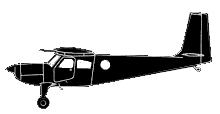
ASN Wikibase Occurrence # 385831
This information is added by users of ASN. Neither ASN nor the Flight Safety Foundation are responsible for the completeness or correctness of this information.
If you feel this information is incomplete or incorrect, you can submit corrected information.
| Date: | Saturday 2 June 2001 |
| Time: | 09:30 LT |
| Type: |  Helio H-391B |
| Owner/operator: | Aurora Venturs Inc. |
| Registration: | N25BA |
| MSN: | 011 |
| Year of manufacture: | 1955 |
| Total airframe hrs: | 2225 hours |
| Engine model: | Lycoming G-0435C2B2-6 |
| Fatalities: | Fatalities: 0 / Occupants: 1 |
| Aircraft damage: | Substantial |
| Category: | Accident |
| Location: | Anvik, AK -
 United States of America United States of America
|
| Phase: | Take off |
| Nature: | Executive |
| Departure airport: | Anvik, AK |
| Anvik, AK (K40) | |
| Investigating agency: | NTSB |
| Confidence Rating: |
The private certificated pilot was departing a river in a float-equipped airplane. During the takeoff run, the airplane came up on-step, but started to veer to the left. The pilot was holding full right rudder, but the airplane continued to turn left. He aborted the takeoff, but the left float collided with the bank of the river, and the right wing struck a tree. The airplane received damage to the left float assembly, the fuselage at the forward left float attach point, and the leading edge wing slat of the right wing. The float assembly was installed the previous month, 11.5 hours before the accident under a Supplemental Type Certificate (STC). Since the float installation, the pilot said he had trouble obtaining full right rudder travel of the aerodynamic rudder. After the accident, a mechanic found an incorrect set of springs, as part of the water rudder/aerodynamic rudder rigging, installed on the airplane. An FAA airworthiness inspector reviewed the tail spring concerns raised by the pilot. She found that the float installation STC specified the use of D-376 water rudder steering springs. Due to the lack of immediate availability, the installer used Scott 3200 tailwheel steering springs. The installer told the FAA inspector that due to the similarity of the two spring sets, he has utilized Scott 3200 tailwheel springs in the past on other float installations, utilizing FAA field approvals, and substitution of the springs have been widely used in the floatplane industry. In this case, the installer did not obtain an FAA field approval. The installer told the FAA that when the floats were installed on the accident airplane, the rigging of the water and aerodynamic rudders allowed proper movement of each assembly. The installer reported that the difference in the two spring assemblies, as measured by applying a 40 pound weight to each set, was 3/8 inch further extension of the D-376 springs.
Probable Cause: The pilot's continued operation of the accident airplane with known equipment deficiencies, and an improper installation of the float assembly by maintenance personnel. A factor in the accident was the pilot's delay in aborting the takeoff.
Accident investigation:
 |
|
Sources:
NTSB ANC01LA066
History of this aircraft
Other occurrences involving this aircraft
| 24 May 2002 | N25BA | Clifford Hickson | 0 | Cheyenne, Wyoming |  |
sub |
Location
Revision history:
| Date/time | Contributor | Updates |
|---|---|---|
| 05-Apr-2024 08:20 | ASN Update Bot | Added |
Corrections or additions? ... Edit this accident description
The Aviation Safety Network is an exclusive service provided by:


 ©2024 Flight Safety Foundation
©2024 Flight Safety Foundation